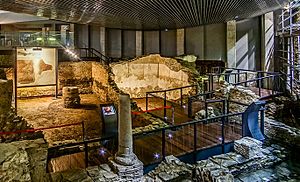University Museum A Domus do Mitreo facts for kids
 |
|
| Lua error in Module:Location_map at line 420: attempt to index field 'wikibase' (a nil value). | |
| Established | March 22, 2018 |
|---|---|
| Location | Praza de Pío XII, 3 Lugo, Galicia (Spain), Spain |
| Collections | Roman archeology, epigraphy, numismatics, ceramics, glass |
| Architect | Felipe Peña |
| Owner | University of Santiago de Compostela |
The University Museum A Domus do Mitreo is a special museum in Lugo, Spain. It's built right next to the ancient Roman walls of Lugo. This museum is unique because it was built around amazing old Roman ruins found underground!
Contents
What is the Domus do Mitreo Museum?
The museum's full name is the University Museum A Domus do Mitreo. It's a place where you can explore history. It was built on the site of an old palace called Pazo de Montenegro. When they started digging to build the new museum, they found something incredible.
Discovering Ancient Roman Homes
Archaeologists found the remains of an ancient Roman house. These houses were called a domus. A domus was a large, fancy home where wealthy Roman families lived. Finding one was a big deal!
The Mystery of the Mithraeum
Later, during the time of the Lower Roman Empire, part of this domus was changed. It became a private building used as a Mithraeum. A Mithraeum was a special temple. It was used for worshipping a Roman god named Mithras. These temples were often built underground or in caves.
Building Around History
The old Roman house and the Mithraeum were very important discoveries. Because of them, the plans for the new museum had to change. The builders decided to keep these ancient ruins. They made sure the new museum building protected and showed off these amazing historical finds. The museum officially opened on March 22, 2018.
See also
 In Spanish: Museo Universitario A Domus do Mitreo para niños
In Spanish: Museo Universitario A Domus do Mitreo para niños

